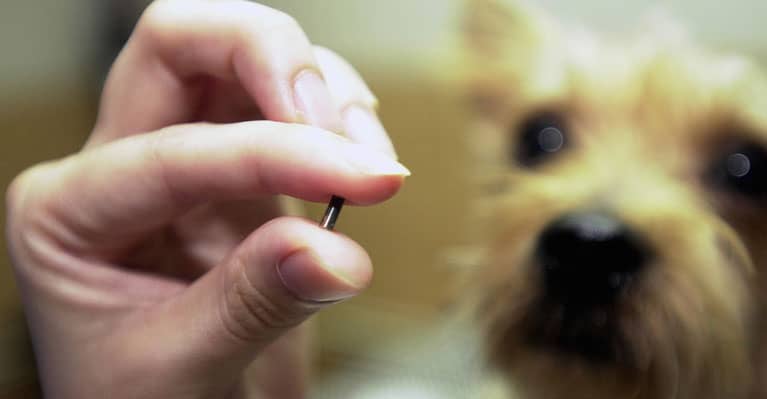As a dog owner, one of your biggest concerns is being involuntarily separated from your pooch.
Sadly, that happens more than we care to think.
Stats by the American Humane claim that about 10 million pets get lost in the US every year.
Out of these, only 15% of dogs in shelters without identification are reunited with their owners.
From dogs escaping the property to getting lost during walks, there are many ways in which a pup can slip away without the knowledge of its owners.
Your pup can also get stolen by a malicious person hoping to sell it for good cash.
One of the most effective ways of ensuring your dog is returned to you when he gets lost is microchipping him.
Unlike the common tags and collars that can easily be removed, microchips are installed under the skin. They offer a sure way of identifying your pup.
If it is your first time considering putting a chip on your pet, you must have a lot of questions about the whole procedure.
We are here to help. In this guide, we address one of the most common concerns among dog owners, especially when it comes to microchip implantation: the size of a dog’s microchip.
To ensure that you are up to date with the procedure, we have also gone ahead to answer other burning questions surrounding the topic.
Let’s dive right in…
How Big Is a Dog’s Microchip?
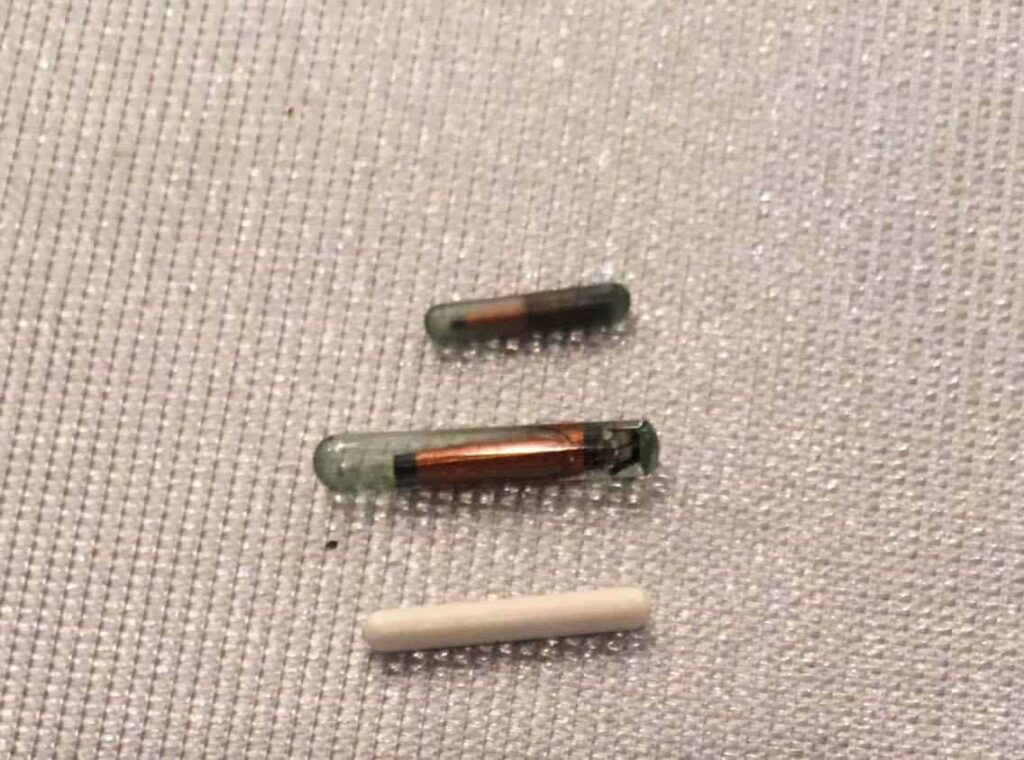
The size of your dog’s microchip is determined by the manufacturer but on average, most chips are the size of a grain of rice (approximately 10MM in length and about 2MM in diameter).
It is possible to have chips that are smaller than these but these would be categorized as nanochips. For instance, the FI nanochip is 1.4MM.
The following table outlines the different microchip sizes from different manufacturers.
| Chip Manufacturer | Size of Chip |
| AVID | 12MM |
| HomeAgain | 12MM |
| Digital Angle | 11MM |
| BuddyID | 10MM |
| SaveThisLife | 8MM and 12MM |
| Fi | 1.4MM |
| PetKey | 1.44MM |
Components of a Dog’s Microchip
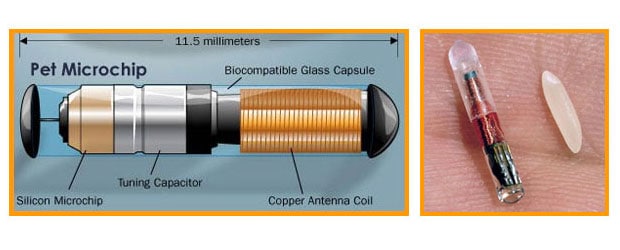
A dog microchip is made of a small glass capsule that contains a radio-frequency identification (RFID) tag.
The RFID tag stores information about the dog, such as the owner’s contact information.
Unlike other RFID tags, the ones used on dogs don’t have to actively transmit information—they just carry the identification information which can be accessed when the need arises.
Some manufacturers may include a cap made of polypropylene polymer. This polymer is designed to encourage cells and other kinds of tissue to hold it in place and this helps to ensure the chip doesn’t keep moving around once it has been planted inside the dog.
The RFID chip is made of several components that are encapsulated in a bioglass.
The bioglass is not toxic and cannot, therefore, harm the dog in any way.
Inside the capsule is the real chip which is made from silicon and it also comes with an antennae coil and a tuning capacitor.
The microchip is powered by a capacitor and the copper antenna helps to relay the information in the chip.
These components are very tiny because the entire casing is the size of a rice grain.
What about the microchip needle? How Big Is It?
According to PetMD, the sizes of the needle vary from company to company but expect a range of 12-15 gauge (0.019-0.072 inches) in diameter.
The lower range (12 gauge) was the standard size of the past microchip needles.
The upper range (15 gauge) is the current size of the newer microchip needles and are often used to deliver minichips.
Either way, the needles are tiny and perfect for installing a chip into your dog.
Does The Dog Feel Pain During Implantation?
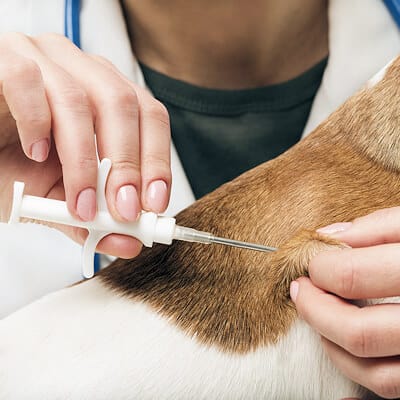
Implanting a microchip on your dog involve inserting it under his skin using a needle.
Needles, however small they are, prick the skin. That has got to hurt a little.
We would be lying if we said that your pup will feel zero pain during installation.
The procedure will sting a little but that’s about it according to Dr. Linda Simon, a vet consultant with Five Barks.
She compares the procedure to getting a piercing for a human being.
The pain is sharp but so short-lived that your dog will manage to get through it.
The expert also says that young or extremely sensitive dogs get numbing creams but most dogs handle it without any issue.
How Does the Microchip Appear On a Dog?
By simply looking at a dog, it is impossible to tell whether a dog has been microchipped or not.
The chip is a super-tiny object inserted under the skin of the dog with tissue surrounding it.
You can only feel it (if you are lucky) or scan it to know if it is there in the first place.
Can U Feel A Dog’s Microchip?

Dog microchips are carefully placed between the pup’s shoulder blades. This position helps keep them in place.
If inserted correctly, the chip becomes difficult to feel with your bare hands.
However, if you know how to work your fingertips well, you may feel something.
Don’t count on it though. Most people cannot feel the chip at all.
How Do You Tell If A Dog Is Microchipped?
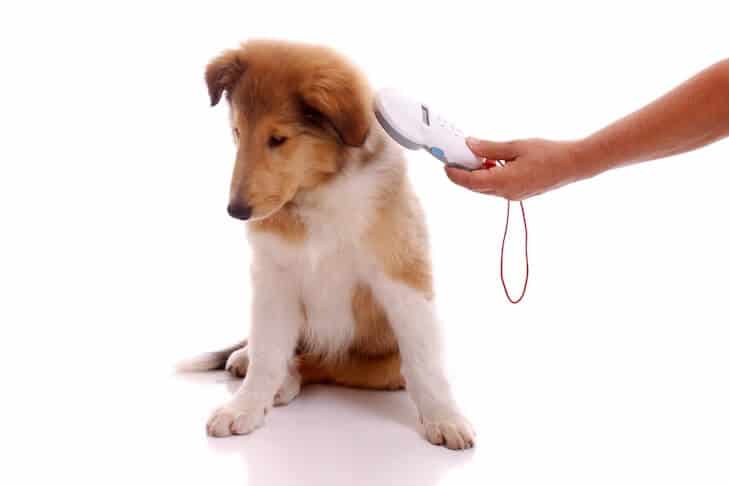
First things first, check the dog’s collar for a metal tag indicating that it has been microchipped.
Some companies supply these tags to alert any interested party that the pooch has a chip under his skin.
If there’s no tag in place, feel for the microchip.
To do this, run your fingers while applying gentle pressure over the dog’s shoulder and neck regions.
You are looking for a tiny object the size of a grain of rice. You should be able to feel it.
If not, don’t conclude anything yet. Chances are the chip has shifted in another direction or is just embedded deep in the dog’s skin.
Dog Microchip Lump

Although rare, a microchip can cause the formation of a lump on the injection area.
For one, some dogs react to these RFIP devices by forming pockets filled with blood or clear fluid, inflammation, infections, and extra skin layers.
Secondly, during the implantation of a microchip, a gel may be inserted with the microchip to keep it in place. There are times when the gel collects in a specific area, causing a lump.
Blood vessels may also burst during implantation, causing blood-filled blisters, which appear as lumps.
Lumps around the site can also be caused by the development of a tumor or fatty tissue.
Occasionally, the chip itself may protrude from the surface of your dog’s skin and create a tiny lump.
Finally, there is a possibility of your dog having an infection during implantation, which may develop into a lump. Most cases are painful since they contain blood and pus. But they can be contained with oral antibiotics.
By and large, microchip lumps may cause you to be concerned but they are actually harmless.
However, if you notice a worrisome growth, take the dog to the vet immediately for a checkup.
Can a Dog’s Microchip Move?
When a dog’s microchip is correctly inserted, the tissue surrounding it attaches itself thereby keeping the chip in place.
However, in big super-active dogs and those with loose skin, the chip may move slightly out of place.
Most often than not, it will shift from one shoulder to another except in rare cases when the microchip will travel to the belly area.
To be safe, it is a good idea to scan the chip from time to time to establish its position.
Potential Health Risks of Dog Microchips

Microchips have made tracking dogs easier than before. However, they are not entirely without negative reports.
If the British Small Animal Veterinary Association (BSAVA) stats are anything to go by, only 391 adverse reactions out of 4 million animals microchipped since 1996 have been reported.
Most of these include the migration of the microchip from its original position. Only a few were caused by tumor formations.
There were some reports in the past about microchips causing cancer. However, the findings were based on rats and mice developing cancer with implanted chips.
The rats and mice were used to study cancer studies and the tumors found did not directly link to the presence of the microchips.
Other side effects of microchipping include tenderness at the injection site for a day after the procedure, formation of abscess, and tumor encapsulation.
PetMD claims that the benefits far outweigh its side effects.
How Long Does A Microchip Last In A Dog?
According to Home Again, a microchip lasts the lifetime of a dog.
The reason is that it is inert meaning it is chemically inactive. It doesn’t react with any of the dog’s insides.
The glass material surrounding the chip is also biocompatible and doesn’t wear down or expire.
The chip also doesn’t have its internal energy source. Rather, it requires a scanner to activate it. Animal shelters own these scanners given to them by microchip companies.
All this is to say that a dog’s microchip can last as long as it is needed without affecting the dog or wearing it out.
Parting Thoughts
As a pet parent, you want nothing but the best for your furry friend.
Before you have a vet plant a microchip on him, you want to know what to expect including how big the chip is and if it will harm the dog in any way.
Hopefully, this guide has shed some light on some of the questions you have had about dog microchipping.
As an Amazon Associate, we may receive a small commission from qualifying purchases but at no extra cost to you. Learn more. Amazon and the Amazon logo are trademarks of Amazon.com, Inc, or its affiliates.

